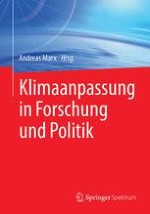2017 | OriginalPaper | Buchkapitel
7. Wissenschaftliche Information für die Anwendung
verfasst von : Andreas Marx, Renate Treffeisen, Klaus Grosfeld, Wolfgang Hiller, Georg Heygster, Luis Samaniego, Rohini Kumar, Julia Pommerencke, Matthias Zink
Erschienen in: Klimaanpassung in Forschung und Politik
Verlag: Springer Fachmedien Wiesbaden
Aktivieren Sie unsere intelligente Suche, um passende Fachinhalte oder Patente zu finden.
Wählen Sie Textabschnitte aus um mit Künstlicher Intelligenz passenden Patente zu finden. powered by
Markieren Sie Textabschnitte, um KI-gestützt weitere passende Inhalte zu finden. powered by
